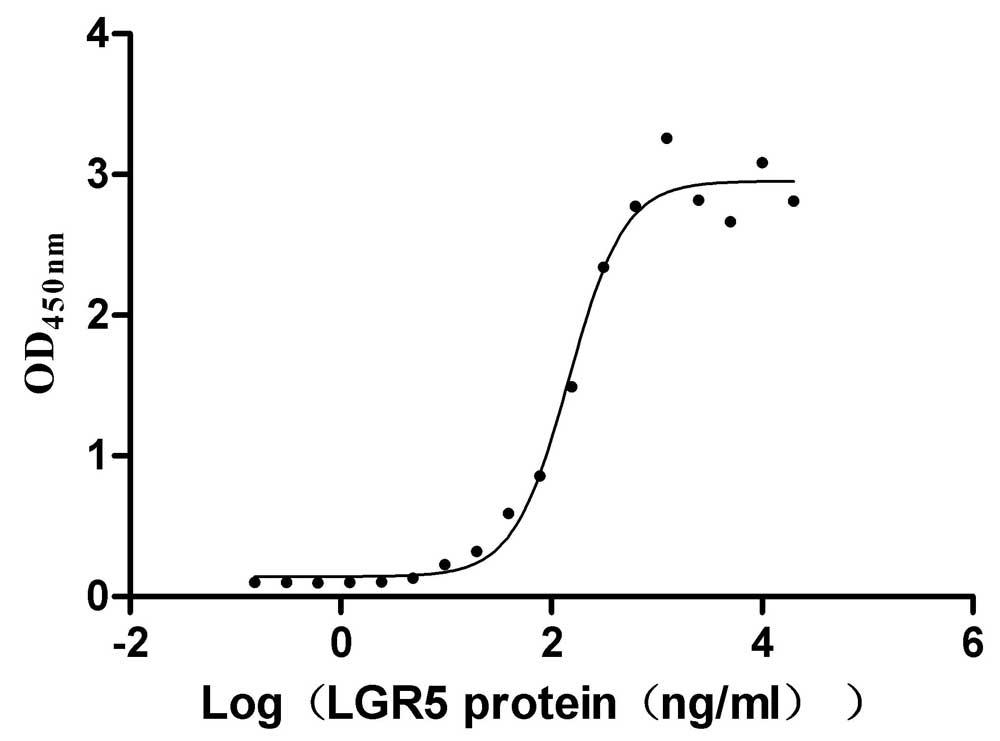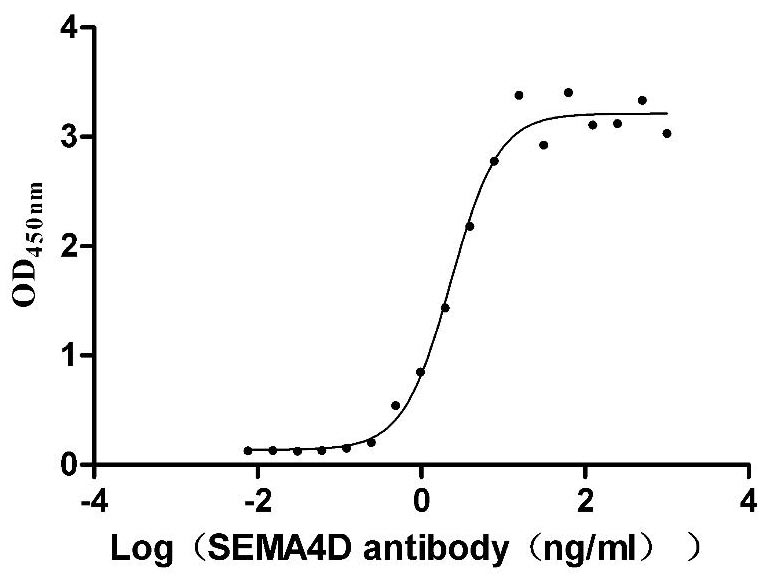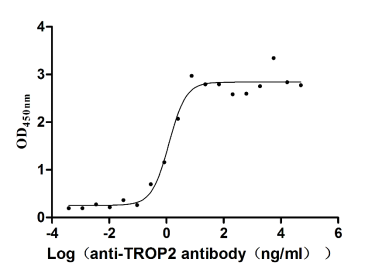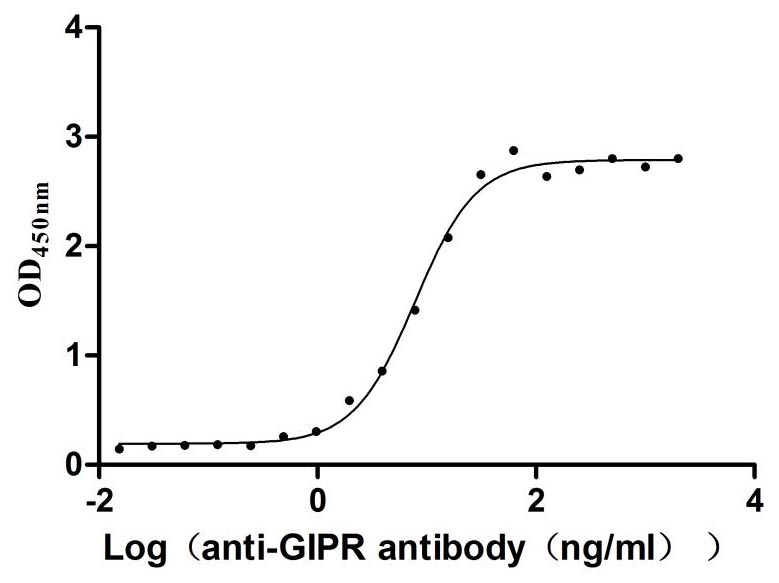Recombinant Mouse Carcinoembryonic antigen-related cell adhesion molecule 1 (Ceacam1), partial
-
货号:CSB-YP005157MO1
-
规格:
-
来源:Yeast
-
其他:
-
货号:CSB-EP005157MO1
-
规格:
-
来源:E.coli
-
其他:
-
货号:CSB-EP005157MO1-B
-
规格:
-
来源:E.coli
-
共轭:Avi-tag Biotinylated
E. coli biotin ligase (BirA) is highly specific in covalently attaching biotin to the 15 amino acid AviTag peptide. This recombinant protein was biotinylated in vivo by AviTag-BirA technology, which method is BriA catalyzes amide linkage between the biotin and the specific lysine of the AviTag.
-
其他:
-
货号:CSB-BP005157MO1
-
规格:
-
来源:Baculovirus
-
其他:
-
货号:CSB-MP005157MO1
-
规格:
-
来源:Mammalian cell
-
其他:
产品详情
-
纯度:>85% (SDS-PAGE)
-
基因名:
-
Uniprot No.:
-
别名:Ceacam1; Bgp; Bgp1; Carcinoembryonic antigen-related cell adhesion molecule 1; Biliary glycoprotein 1; BGP-1; Biliary glycoprotein D; MHVR1; Murine hepatitis virus receptor; MHV-R; CD antigen CD66a
-
种属:Mus musculus (Mouse)
-
蛋白长度:Partial
-
蛋白标签:Tag type will be determined during the manufacturing process.
The tag type will be determined during production process. If you have specified tag type, please tell us and we will develop the specified tag preferentially. -
产品提供形式:Lyophilized powder
Note: We will preferentially ship the format that we have in stock, however, if you have any special requirement for the format, please remark your requirement when placing the order, we will prepare according to your demand. -
复溶:We recommend that this vial be briefly centrifuged prior to opening to bring the contents to the bottom. Please reconstitute protein in deionized sterile water to a concentration of 0.1-1.0 mg/mL.We recommend to add 5-50% of glycerol (final concentration) and aliquot for long-term storage at -20℃/-80℃. Our default final concentration of glycerol is 50%. Customers could use it as reference.
-
储存条件:Store at -20°C/-80°C upon receipt, aliquoting is necessary for mutiple use. Avoid repeated freeze-thaw cycles.
-
保质期:The shelf life is related to many factors, storage state, buffer ingredients, storage temperature and the stability of the protein itself.
Generally, the shelf life of liquid form is 6 months at -20°C/-80°C. The shelf life of lyophilized form is 12 months at -20°C/-80°C. -
货期:Delivery time may differ from different purchasing way or location, please kindly consult your local distributors for specific delivery time.Note: All of our proteins are default shipped with normal blue ice packs, if you request to ship with dry ice, please communicate with us in advance and extra fees will be charged.
-
注意事项:Repeated freezing and thawing is not recommended. Store working aliquots at 4°C for up to one week.
-
Datasheet :Please contact us to get it.
相关产品
靶点详情
-
功能:Cell adhesion protein that mediates homophilic cell adhesion in a calcium-independent manner. Plays a role as coinhibitory receptor in immune response, insulin action and functions also as an activator during angiogenesis. Its coinhibitory receptor function is phosphorylation- and PTPN6 -dependent, which in turn, suppress signal transduction of associated receptors by dephosphorylation of their downstream effectors. Plays a role in immune response, of T-cells, natural killer (NK) and neutrophils. Upon TCR/CD3 complex stimulation, inhibits TCR-me...显示更多
-
基因功能参考文献:
- regulator of local immune response in the liver, whereby CEACAM1S seems to control regulatory T cell induction PMID: 29377208
- CEACAM1 controls epithelial-mesenchymal transition in vitro and in vivo by site-specific regulation of beta-catenin phosphorylation PMID: 27572314
- A 30-day high fat feeding regimen demonstrated that white adipose tissue-derived fatty acids repressed hepatic CEACAM1-dependent regulation of insulin and lipid metabolism in 3-month-old male C57BL/6J mice. PMID: 27777319
- determined the crystal structure of mCEACAM1b and identified the structural differences and additional residue differences between mCEACAM1a and mCEACAM1b that affect MHV binding and entry PMID: 28035001
- REVIEW: summarizes the vascular effects of CEACAM1 and focuses on its role in vascular morphogenesis and endothelial barrier regulation PMID: 27695943
- CEACAM1 exacerbates hypoxic cardiomyocyte injury and post-infarction cardiac remodeling by enhancing cardiomyocyte mitochondrial dysfunction and endoplasmic reticulum stress-induced apoptosis. PMID: 26911181
- The increase in total fat mass in Cc1(-/-) mice is mainly attributed to hyperphagia and reduced spontaneous physical activity. Although the contribution of the loss of CEACAM1 from anorexigenic proopiomelanocortin neurons in the arcuate nucleus is unclear, leptin resistance and elevated hypothalamic fatty-acid synthase activity could underlie altered energy balance in these mice. PMID: 27002145
- Ceacam1 is essential for normal integrin aIIbb3-mediated platelet function; the disruption of mouse Ceacam1 induced moderate integrin aIIbb3-mediated functional defects. PMID: 26196244
- hepatic CEACAM1 expression at fasting is mediated by Pparalpha-dependent mechanisms. PMID: 26846848
- Gram-positive bacteria promote the mRNA expression of CEACAM1 or CEACAM20 in the small intestine. Inflammatory cytokines or butyrate likely participates in such effects of commensal bacteria. PMID: 25908210
- CEACAM1 is a crucial regulator of B-cell survival, influencing B-cell numbers and protective antiviral antibody responses PMID: 25692415
- High-fat diet amplifies the permissive effect of Ceacam1 deletion on renal expression of all renin-angiotensin system components, PI3K phosphorylation, inflammation, and fibrosis. PMID: 26374765
- Ceacam1L acts as a crucial factor in glioblastoma-initiating cell maintenance and tumorigenesis by activating c-Src/STAT3 signaling. Monomers of the cytoplasmic domain of Ceacam1L bound to c-Src and STAT3 and induced their phosphorylation. PMID: 26238781
- CEACAM1 levels in the liver were reduced in prenatally stressed diet-induced obesity offspring after the high fat diet challenge, suggesting that preexisting genetic predisposition combined with prenatal stress increases the risk for obesity in adulthood. PMID: 26219866
- high-fat diet reduced hepatic CEACAM1 expression and that overexpressing CEACAM1 in liver curtailed diet-induced metabolic abnormalities by protecting hepatic insulin clearance. PMID: 25972571
- a physiologic role of CEACAM1 in the regulation of osteoclastogenesis PMID: 25490771
- CD66a and CD117 may be useful markers to isolate several cell types consisting of SMG epithelium and to analyze their molecular and cellular nature. PMID: 25498293
- expression significantly reduced in the colon tissue of mice with ulcerative colitis PMID: 25724769
- This is the first study demonstrating that CEACAM1 enhances vascular remodeling and tuft regression by increasing endothelial resistance to alterations in oxygen tension, thus accelerating vascular recovery after systemic hypoxia. PMID: 25406283
- CEACAM1 serves as a heterophilic ligand for TIM-3 that is required for its ability to mediate T-cell inhibition, and this interaction has a crucial role in regulating autoimmunity and anti-tumour immunity PMID: 25363763
- CEACAM1 controls matrix metalloproteinase-9 secretion by neutrophils in postischemic inflammation at the blood brain barrier after stroke. PMID: 23780386
- CEACAM1 on activated NK cells functions as an inhibitory receptor for NKG2D-mediated cytolysis, which has important implications for understanding the means by which CEACAM1 expression adversely affects tumor immunity. PMID: 23696226
- These results suggest that CEACAM1 has roles in the initiation of palatal fusion via epithelial cell adhesion. PMID: 23613893
- Data from knockout mice suggest that Ceacam1 plays role in regulation of vascular endothelial reactions (such as nitric oxide production) to oxidative stress/lipid peroxidation and prevention of plaque-like lesions in large vessels such as aorta. PMID: 23800882
- global null deletion of Ceacam1 caused an increase in blood pressure with increased renin-angiotensin system activation together with upregulation of prorenin receptor via PI3K-Akt activation of CREB-1, ATF-1, ATF-2, and NF-kappaB p65. PMID: 23734002
- PKC-epsilon can affect insulin uptake in mouse embryonic fibroblasts through promotion of receptor-mediated endocytosis, and that this may be mediated by regulation of CEACAM1 expression. PMID: 23469261
- Carcinoembryonic antigen cell adhesion molecule 1 promotes metastasis of colorectal cancer. PMID: 22469976
- This tissue resident predominance of CEACAM1-S expression was determined by the intestinal environment. PMID: 23123061
- CEACAM1 expression on CD11b(+)/Gr-1(+) myeloid cells is a prerequisite for adequate collateral formation. PMID: 22962327
- Neither of the two CEACAM1 isoforms defines hepatitis virus organ tropism. PMID: 22673933
- Findings show that CEACAM1 negatively regulates Gr1(+)CD11b(+) myeloid cell-dependent tumor angiogenesis by inhibiting the G-CSF-Bv8 signaling pathway. PMID: 22406619
- CEACAM specific T84.1 antibody binds to tumour cells in the vicinity of blood vessels PMID: 22162753
- CEACAM1 dampens antitumor immunity by down-regulating NKG2D ligand expression on tumor cells. PMID: 22143889
- Data show that CEACAM1 expression in the tumor periphery determines the vascular phenotype in a tumor, whereas systemic absence of CEACAM1 interferes with the formation of an organized tumor matrix and intratumoral vessel maturation. PMID: 21532628
- Ceacam1 was studied as a regulator of graft-versus-host-disease and graft-versus-tumor after allogeneic bone marrow transplantation (allo-BMT) in mouse models. PMID: 21760897
- This data represents the first report of a functional link between CEACAM1 and the VEGFR2/Akt/eNOS-mediated vascular permeability pathway. PMID: 21081647
- CEACAM1 acted as a coinhibitory receptor for G-CSFR regulating granulopoiesis and host innate immune response to bacterial infections. PMID: 21029969
- ceacam1a mRNA expression was quantified in murine tissues and primary cells; ability of virus to spread to adjacent cells in ceacam1a knockout mice was species dependent PMID: 20739537
- These results strongly support the hypothesis that although alleles of mCEACAM1 are the principal determinants of mouse susceptibility to mouse hepatitis virus -A59, other as-yet-unidentified murine genes may also play a role. PMID: 20410265
- In contrast to epithelial cells and other cell types, CEACAM1 expression on the cell surface of mouse T cells is revealed only upon activation and requires neither de novo transcription or translation. PMID: 11801635
- regulates insulin clearance in liver PMID: 11850617
- Both long and short cytoplasmic domain isoforms of Ceacam1 are expressed in mouse neutrophils, B cells, and T-cells. PMID: 11994468
- homophilic CEACAM1-CEACAM1 cell-mediated binding is the physiological stimulus for CEACAM1-triggered B cell signaling PMID: 12832451
- the transmembrane domain of CEACAM1 is responsible for the Cdc42-induced targeting at cell-cell contacts PMID: 14517298
- CD98 stimulation by anti-CD98 antibodies induced CEA-CAM-1-mediated cell adhesion PMID: 14527684
- CEACAM1 isoforms are a novel class of activation-induced cell surface molecules on T cells that function in the specific regulation of Th1-mediated inflammation. PMID: 14970176
- expression on microglia was reduced during acute Murine Hepatitis virus infection and restored following immune-mediated virus control PMID: 15220458
- CEACAM1 has a role in insulin clearance and regulating serum free fatty acid (FFA) levels PMID: 15316023
- CEACAM1a is the sole receptor for mouse hepatitis virus A59 in both liver and brain, and its deletion from the mouse renders the mouse completely resistant to infection by this virus. PMID: 15331748
- Data show that CEACAM1 is a substrate of the epidermal growth factor receptor (EGFR) and that upon phosphorylation, CEACAM1 reduces EGFR-mediated growth of transfected Cos-7 and MCF-7 cells in response to EGF. PMID: 15467833
收起更多
-
亚细胞定位:[Isoform 1]: Cell membrane; Single-pass type I membrane protein. Lateral cell membrane. Apical cell membrane. Basal cell membrane. Cell junction. Cell junction, adherens junction.; [Isoform 2]: Cell membrane; Single-pass type I membrane protein. Lateral cell membrane. Apical cell membrane. Basal cell membrane. Cell junction. Cell junction, adherens junction. Cytoplasmic vesicle, secretory vesicle.; Cell projection, microvillus membrane; Single-pass type I membrane protein. Apical cell membrane; Single-pass type I membrane protein.
-
蛋白家族:Immunoglobulin superfamily, CEA family
-
组织特异性:Expressed in granulocytes, lymphocytes, granulocytes, B cells, and T-cells. Expressed in bone. Highly expressed in liver and femur. Highly expressed in neutrophils, and to a lesser extent inmonocytes, and macrophages. Slightly higher expressed in peripher
-
数据库链接:
KEGG: mmu:26365
STRING: 10090.ENSMUSP00000096266
UniGene: Mm.322502

















